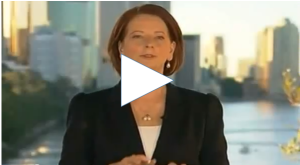Does the carbon tax live up to its expectations?

The carbon tax is driving up prices of energy and consumables and is being resented by many business owners and consumers. We all want more money in our hip pocket at the end of the week but, is carbon worth the price?
Bringing in the carbon tax has been a political issue and cat fight over the last two years. In all honesty, most of us are sick of hearing about it. Whilst most of us never wanted one, including some of our politicians, we looked a little deeper into what the carbon tax really is.
Enjoy Bill Richmond’s insights into what the carbon tax is really about and whether it is worth the cost.
 What’s the ‘carbon tax’ all about?
What’s the ‘carbon tax’ all about?
As elders in our community do we have a responsibility to understand the ‘big issues’ and take an active and informed part in economic and social policy debates? The carbon tax is one of the major issues in the forthcoming election and one policy which the present opposition has unequivocally vowed to abolish. So what’s it all about?
The term ‘carbon’ is shorthand for the gases emitted into the earth’s atmosphere by a variety of economic activities. A major gas is carbon dioxide – hence use of the term ‘carbon’. Gases are emitted from a variety of economic activities but particularly from the burning of fossil fuels, notably coal, in order to generate electricity. They create a ‘greenhouse effect’, the major consequence of which is a warming of the planet’s atmosphere (‘global warming’) and the creation of unstable weather patterns resulting in major events such as floods, droughts and storms.
There are of course people (often termed ‘sceptics’) who don’t agree with the view that these phenomena can be attributed to human activity, in particular the burning of fossil fuels such as coal. Sceptics don’t necessarily deny ‘climate change’ but they do deny that it is being caused by what we do. But there is a widespread view – even, dare we call it, a consensus? – that we (the human race) should stop doing things that create greenhouse gases.
The question is: how?
The first step is to establish a ‘target’ reduction in emissions in order to slow the process of climate change. The current Australian government (broadly in line with governments of some other industrial countries) has adopted a target of an 80 percent reduction by 2050 and the shorter term goal (some would say very, even too, modest) of a reduction of at least 5 percent by 2020.
This can be achieved by a variety of means. One is to put a price on carbon. This has the effect of making the actions of firms and individuals that result in the emissions of greenhouse gases more expensive. Accordingly, firms that produce products in a way that results in emissions (or produce products whose use results in emissions) will be encouraged to adopt different methods or produce different types of products. Those firms that don’t will have to pay the price for emitting gases (because there’s a price on carbon). In the short term they can pass any increased cost on to buyers of their products (‘consumers’) but in the longer term they will become increasingly uncompetitive and go out of business. On the other hand firms that adopt processes, or produce products, that do not result in the emission of gases – and thus do not have to pay a price to do so – will prevail. The result: a ‘low (or no) carbon economy’ where global warming (and the other effects of climate change) do not occur.
The issue then is: how is the price on carbon determined?
A government whose aim is to reduce emissions can simply set a price at a level that it estimates will serve to bring about its target reduction. Or it can allow the forces of supply and demand (what economists term ‘the market’) to establish the price that is consistent with the target it has set. In this case the government doesn’t need to do anything other than establish and administer a market – what is generally termed an emissions trading scheme (ETS).
An ETS works through the issue of permits to firm which allow them to emit carbon above the target level. Firms whose activities result in them requiring these permits have to buy them. On the other hand if a firm doesn’t emit carbon it doesn’t need permits and can actually sell them. This creates a market in permits. Demand and supply forces result in a price, just as in any other market
A proposal to establish an ETS was in fact taken to the 2007 Australian election by the Howard Government, with Malcolm Turnbull as Minister for the Environment. After 2007 Turnbull continued to support such a scheme. In fact the speech he made in parliament in 2010 is one of the better parliamentary speeches on the subject. But this policy has subsequently been rejected by the Opposition parties.
The current Australian government is in the process of implementing an ETS, designed to come into operation in mid-2015. (Whether or not we’ll ever see this is an open question.) This ETS has a ‘lead-in’ period that started in July 2012. During this period the price of carbon has been set by the government at a level that it has estimated approximates the price that will be set by the market when an ETS would come into operation.
The desirability and need for such a ‘lead-in’ period, and the practicalities of introducing an ETS, can be debated. Whatever the case the adoption of a fixed price over 2012-2015 has allowed the price to be characterised as a ‘tax’ – the ‘carbon tax’. Whether or not this can properly be labelled a ‘tax’ is a moot point – though note that (in part at least for purely political reasons) members of the current government have only ever referred to it as ‘a price on carbon’.
Whatever terminology we use, however, the key question remains: is this a good policy? On the one hand consumers and producers of goods and services whose production results in the emission of greenhouse gases (for example in the production of electricity by burning coal) will necessarily pay higher prices, at least in the short term. But that’s actually intentional: firms will find ways of avoiding using anything that costs more. On the other hand the policy will have the longer-term benefit of stopping the emission of gases that (according to the majority view) will result in climate change and the degradation of life on earth.
But is there a better way of achieving the same result? Certainly an alternative policy (one that has been labelled ‘direct action’) is being taken to the election later this year by the current Opposition.
Generations following are going to judge us critically on what we do – or don’t do – in the next year or so. Do you feel you should know more about this subject? Let us know.









 Proudly Australian owned and operated
Proudly Australian owned and operated